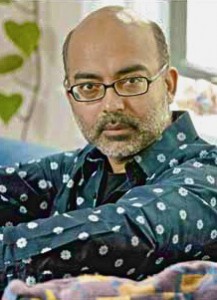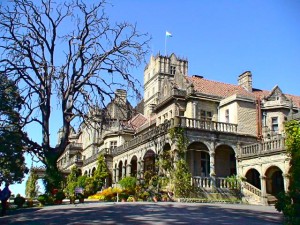“Everything flows. Nothing is constant. India was once a part of Africa, and India separated from Africa, turned and moved and turned and moved and collided with Asia. India was never constant, and its Himalayas were never constant, they are still growing…and after all the growing they will shrink and turn and shrink and turn again.”—Dr. Raj Kumar
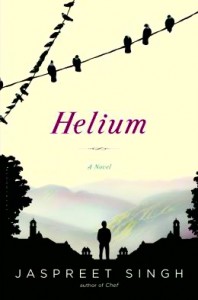 Dr. Raj Kumar, the speaker of this ambitious and often exhilarating novel, decides, ultimately, that “What holds things together is more important than what separates them,” but by the time he discovers this, he has explored the world on more levels and examined life in more detail than one finds in ten novels by many other authors. I cannot recall a novel which has kept me reading so slowly and so happily for so long. Brimming with unusual insights, the novel remains firmly focused on life itself, not just on the speaker’s life, but on the grandest and sometimes most horrific aspects of all life—socially, historically, artistically, scientifically, and even cosmically. As I read this, I was constantly in awe of author Jaspreet Singh’s creativity, vision, and literary execution, and I am still recalling some of the novel’s finest moments, while at the same time wishing my non-scientific background had not limited my insights into some of the author’s other, more arcane imagery.
Dr. Raj Kumar, the speaker of this ambitious and often exhilarating novel, decides, ultimately, that “What holds things together is more important than what separates them,” but by the time he discovers this, he has explored the world on more levels and examined life in more detail than one finds in ten novels by many other authors. I cannot recall a novel which has kept me reading so slowly and so happily for so long. Brimming with unusual insights, the novel remains firmly focused on life itself, not just on the speaker’s life, but on the grandest and sometimes most horrific aspects of all life—socially, historically, artistically, scientifically, and even cosmically. As I read this, I was constantly in awe of author Jaspreet Singh’s creativity, vision, and literary execution, and I am still recalling some of the novel’s finest moments, while at the same time wishing my non-scientific background had not limited my insights into some of the author’s other, more arcane imagery.
The speaker, Dr. Raj Kumar, has returned to his native Delhi twenty-five years after he left to attend college at Cornell University. He remained there, obtaining his doctorate and becoming a professor specializing in rheology, the study of the flow of complex materials, which he describes as “materials with memory.” (This is illustrated clearly and more fully in the book.) He is also fascinated with the element of helium, “the noble gas” – a primordial element which “prefers isolation and solitude,” as it constantly escapes the earth’s gravitational field. However complex this may sound, the speaker uses these images symbolically and successfully as he tries to understand himself and his own search for information about an event which he witnessed in Delhi in 1984 and which has left him traumatized ever since. Now married and the father of two American children, Raj is essentially a loner, preferring isolation and solitude (like the element helium). Returning to India to confront his past, he sorts through the flow of his own memories (a kind of personal rheology) and tries to understand them and their significance in the context in which they have occurred. In the process, he also discovers that events related to his trauma, but which he knows nothing about, have affected others around him in extraordinary ways. Ultimately, he must uncover the whole past if he is to understand who he really is and what his obligations are, if any, as a human being.
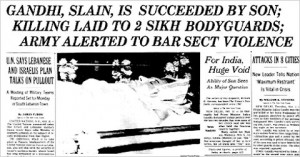 Moving backward and forward through time as his memories return, develop, revise themselves, and then become new memories, Raj Kumar describes his earlier life, from his time as an 18-year-old student in 1984, up to the present in India, where he has been doing research about important historical events in which he was unwillingly caught up. His most traumatic memory occurred when, as a graduating high school student, he returned from a class trip to Shimla with a few classmates and his favorite professor, a Sikh with whom he had been close. During lunch on the day of the return trip home, someone turned on the radio and discovered that Prime Minister Indira Gandhi had been assassinated by two of her bodyguards, both Sikhs. When the train with the students and professor arrived in Delhi, disaster struck. An anti-Sikh mob attacked the turban-clad teacher at the station, putting an automobile tire around his shoulders, spraying him with oil, and setting him afire. Further rioting after Mrs. Gandhi’s death eventually cost over three thousand Sikh lives, and life changed forever for those who were “lucky” enough to survive.
Moving backward and forward through time as his memories return, develop, revise themselves, and then become new memories, Raj Kumar describes his earlier life, from his time as an 18-year-old student in 1984, up to the present in India, where he has been doing research about important historical events in which he was unwillingly caught up. His most traumatic memory occurred when, as a graduating high school student, he returned from a class trip to Shimla with a few classmates and his favorite professor, a Sikh with whom he had been close. During lunch on the day of the return trip home, someone turned on the radio and discovered that Prime Minister Indira Gandhi had been assassinated by two of her bodyguards, both Sikhs. When the train with the students and professor arrived in Delhi, disaster struck. An anti-Sikh mob attacked the turban-clad teacher at the station, putting an automobile tire around his shoulders, spraying him with oil, and setting him afire. Further rioting after Mrs. Gandhi’s death eventually cost over three thousand Sikh lives, and life changed forever for those who were “lucky” enough to survive.
During this return to India, Raj intends to visit his father, a former high-ranking policeman, along with the widow of his professor, with whom he stays briefly as a guest. Throughout his stay, he has the constant feeling the “something is not quite right,” but he is unable to figure out what it is. Nelly Singh Kaur, the widow, is about to retire from her job as an archivist, a job located at the Viceregal Lodge from colonial days, now used as an Indian library. As someone widowed by anti-Sikh violence, Nelly hopes to compile an oral history that will finally force people to take responsibility for the events of 1984. The perpetrators of these horrors have never been punished, no one has been held responsible, and no one, apparently, has ever felt any guilt. The alliance of religion and politics, and the existence of religiously based political parties, have allowed perpetrators to feel innocent, as long as their own party has prevailed.
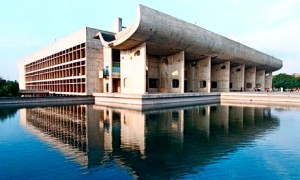
The Chandigarh Legislative Assembly building by Le Corbusier represents a destruction of the past for Raj Kumar.
The issue of personal responsibility on a human level is one of the major themes in this rich and absorbing novel. Is someone responsible for events about which they know nothing when it is in their power, if it is not their personal obligation, to find out about them? Author Jaspreet Singh believes so, as he illustrates through the search for information which Raj Kumar undertakes during his lengthy stay in India. Eventually, Raj learns something which affects him so deeply that it completely changes him, making it impossible for him to remain isolated and uncommitted any longer.
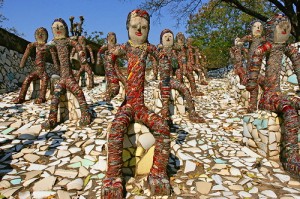
Nek Chand's mosaic figures made from shards and discarded materials represent new meanings for Raj Kumar. Photo by Carol Mitchell.
Throughout this novel, the word “soul” never appears. Instead, the author uses a great deal of bird imagery and flight in its place. The imagery of rheology and of helium pervades the novel, adding scientific and cosmic elements. Political changes in India in the past half century are reflected, physically, by architectural changes, which the author notes throughout. The Viceregal Lodge, serving as an Indian library, is only the beginning. On a trip to Chandigarh, where his father studied, Raj sees buildings by Le Corbusier, who has “erased the past.” Later, he visits the “outsider” Rock Garden with figures by Nek Chand, who assembled sculptures out of shards, broken plates, old tires, and scrap metal, infusing old objects with “new meaning.” Though, near the end, the book bogs down somewhat under the weight of its own themes and images, author Jaspreet Singh has infused this “Indian novel” with new meaning in an ambitious work about people and their responsibilities. He says what he wants to say without restricting himself – committed to ideas, and willing to take chances, stylistically, in order to depict past history in ways that people, twenty-five years later, will recognize as responsible, truthful, and significant. Though he pays homage to Primo Levi and W. G. Sebald with his style, Jaspreet Singh ultimately creates his own style, unique and creatively daring.
ALSO by Jaspreet Singh: CHEF
Photos, in order: The author’s photo appears on http://www.canada.com/
The headline announcing the death of Prime Minister Indira Gandhi is from http://www.voxs.info/2012_10_30_archive.html
The former Viceregal Lodge in Shimla may be found on http://lzscene.files.wordpress.com/
The Chandigarh Legislative Assembly Building by Le Corbusier is from http://www.theguardian.com Photo by Jophn MacDougall. Raj Kumar considered this building to be destructive of the past.
The photo of Nek Chand’s mosaic figures in the Rock Garden is by Carol Mitchell: http://mosaicartsource.wordpress.com/
ARC: Bloomsbury
